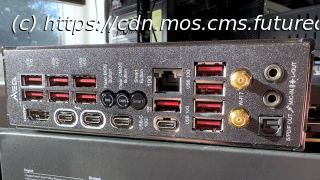Stupendous number of USB ports, stupendous price tag.
The MEG Z890 Ace is one of MSI’s most expensive Intel LGA 1851 motherboards around. It’s not the absolute priciest, as that honour goes to the $1,000 Z890 Godlike. But while the Ace is half the cost, it still sports a very steep price tag for a mere motherboard. So what exactly are you getting for $500 that you don’t get with a $250 model?
Let’s start with the most eye-popping feature, the number of USB ports on the rear IO panel. At first glance, it would seem that you get four Type-C and 11 Type-A sockets for USB devices, but that’s only half the story. Like many mainstream and high-end Core Ultra 200S motherboards, the MEG Z890 Ace sports two Thunderbolt 4 ports.
These support up to 40 Gbps in Thunderbolt 4 mode, 20 Gbps in USB4 mode, or 10 Gbps when operating as USB 3.2 Type-C sockets, as well as providing DisplayPort 2.1 outputs. The other Type-C connections are 10 Gbps USB 3.2, but here’s the really impressive part: So are all the other Type-A ports.
Yes, that’s right. There isn’t a single 5 Gbps or USB 2.0 socket, just a veritable wall of high-speed peripheral connectivity. If you care not one jot about gaming performance, thermal levels, or anything to do with storage, then the MEG Z890 Ace is well worth considering for that alone, assuming the price tag doesn’t put you off.
But there’s even more to drool over. The motherboard is home to three PCIe expansion slots and five M.2 SSD connectors. In the case of the former, two are Gen 5 and are hooked up directly to the CPU, with the remaining slot being Gen 4 and handled by the Z890 chipset. However, while they’re all physically x16 slots, only the primary one is electrically x16; the others are x8 and x4, respectively.
The compromises continue with the M.2 slots, because while three of them are connected to the CPU, and they’re all either Gen 4 or Gen 5 in capability, there’s a fair degree of PCIe lane sharing between the PCIe and M.2 slots.
Basically, the CPU and chipset only have so many to go around, so if you load up every slot with a device or SSD, you’ll have to sacrifice some performance.
There’s no way around this limitation, unfortunately, but at least none of the slots are fully disabled if you choose to use them all, and they don’t affect the USB ports at all.
As with all of MSI’s latest motherboards, there’s a host of user-friendly features to make your PC life that little bit easier. All of the M.2 heatsinks and the primary PCIe slot for a graphics card have quick-release mechanisms, dedicated buttons for clearing and flashing the BIOS, debug LEDs and a display to indicate boot process stages and errors, and even the Wi-Fi antenna just pushes into its sockets (no screws involved).






